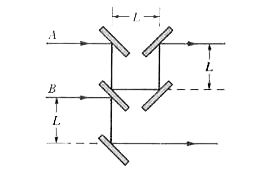In the figure shown, light waves A and B both of wavelength are initially in phase and travelling rightward as incident by the two rays. Wave A is reflected from four parallel surfaces but ends up travelling in original direction. The possible value(s) of distance L in terms of wavelength in figure which put A and B exactly out of phase with each other after all the reflected is/are

The correct Answer is:C
Topper's Solved these Questions
- WAVE OPTICSBOOK - DC PANDEYCHAPTER - WAVE OPTICSEXERCISE - For JEE Advanced Only one option is correct
23 Videos
- WAVE OPTICSBOOK - DC PANDEYCHAPTER - WAVE OPTICSEXERCISE - For JEE Advanced B. More than one option is correct
5 Videos
- WAVE OPTICSBOOK - DC PANDEYCHAPTER - WAVE OPTICSEXERCISE - medical entrances
42 Videos
- SOLVED PAPERS 2018BOOK - DC PANDEYCHAPTER - SOLVED PAPERS 2018EXERCISE - JIPMER
22 Videos
Similar Questions
In Fig., sound waves A and B, both of wavelength λ , are initially in phase and traveling rightward, as indicated by the two rays. Wave A is reflected from four surfaces but ends up traveling in its original direction. Wave B ends in that direction after reflecting from two surfaces. Let distance L in the figure be expressed as a multiple q of λ:L=qλ. What are the (a) smallest and (b) third smallest values of q that put A and B exactly out of phase with each other after the reflections?

View SolutionThe change in phase if a wave is reflected from a rigid surface is
View Solution
Knowledge Check
The change in phase if a wave is reflected from a rigid surface is
AzeroBπ radianC2π radianDπ2 radianA sound source emits two sinusoidal sound waves, both of wavelength λ, along paths A and B as shown in figure.The sound travelling along path B is reflected from five surfaces as shown and then merges at point Q, producing minimum intensity at that point.The minimum value of d in terms of λ is :
 Aλ8Bλ4C3λ8Dλ2
Aλ8Bλ4C3λ8Dλ2A ray of light of wavelength λ is incident on mirror at an angle of incidence 60∘. The wavelength of light after reflection will be
A2λB3λCλ/2Dλ
A sound source emits two sinusoidal sound waves, both of wavelength λ, along paths A and B as shown in figure.The sound travelling along path B is reflected from five surfaces as shown and then merges at point Q, producing minimum intensity at that point.The minimum value of d in terms of λ is :

View SolutionWhen a sound wave is reflected from a wall the phase difference between the reflected and incident pressure wave is:
View SolutionFigure shows two light rays that are initially exactly in phase and that reflect from several glass surfaces. Neglect the slight slant in the path of the light in the second arrangement. The path length difference in terms of wavelength λ is :

View SolutionWhen a sound wave is reflected from a wall the phase difference between the reflected and incident pressure wave is:
View SolutionA sound wave having wavelength λ forms stationary waves after reflection from a surface. The distance between two consecutive nodes is
View Solution
